
Distinguishing Edible Turmeric Varieties
I first started growing turmeric a few years ago. My goal was to collect every known color and edible variety. My first trade was a Hawaiian Red plant for a “black” turmeric plant. However, I noticed this plant looked different than the photos of black turmeric (curcuma caesia) I found on Google. I soon learned that information on distinguishing edible turmeric varieties was as rare as the rhizomes themselves… at least for an English-speaker. My goal in this post is to demystify turmeric for those in English-speaking locations. This post will provide specific information on the edible turmeric varieties that I grow. I hope other gardeners who love turmeric will find it useful.

Red Hawaiian Turmeric (Curcuma Longa)
Rhizome
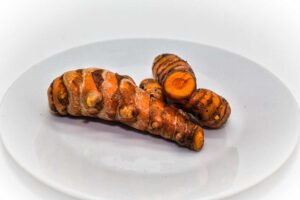
Rhizomes of Red Hawaiian turmeric are of medium size. They tend to retain a bright orange/red coloration that is visible on the outside of the rhizome even when dried. Insides are bright orange to red. Buds are light to bright green when sprouts initially emerge.
Sprout
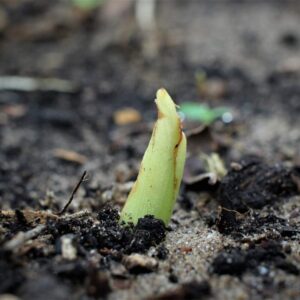
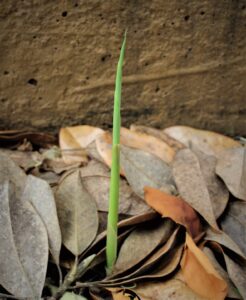
Sprouts remain light to bright green as plants begin to emerge from the soil.
Plant/Foliage
Plants remain light to bright green as leaves emerge. Foliage is green without additional coloration and looks nearly identical to standard orange turmeric. (Please see photo in the standard orange turmeric section).
Flower
Flowers may appear in the middle of foliage mid-summer to early fall. Plants generally will not flower until at least the second year, and may not flower if conditions are not right. The flower petals of Hawaiian red turmeric generally are white with green and purple tips. The flower buds (not pictured, but appear under top petals) are generally yellow.
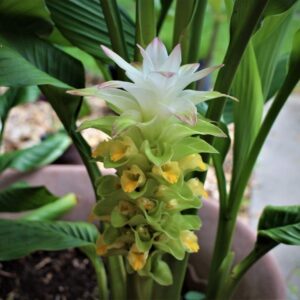
Identification Tips
The easiest way to distinguish Hawaiian Red from other turmeric varieties is the reddish hue of the rhizome. This red color remains even when the rhizome is dried. See photo below.
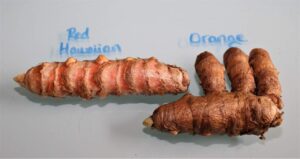
Standard Orange Turmeric (Curcuma Longa)
Rhizome

The most common of the edible turmeric varieties, rhizomes of orange turmeric are of of medium size regarding length and width. Insides are light brown to orange. Buds light green when sprouts initially emerge.
Sprout

Sprouts remain light to bright green as plants begin to emerge from the soil.
Plant
Plants remain light to bright green as leaves emerge. Foliage is green without additional coloration and looks nearly identical to Hawaiian red turmeric (see picture below).
Flower
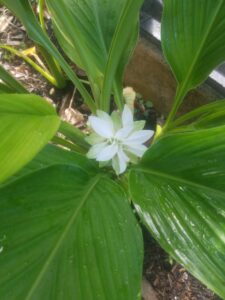
Flowers may appear in the middle of foliage mid-summer to early fall. Plants generally will not flower until at least the second year, and may not flower if conditions are not right. The flower of standard orange turmeric generally is white. Flower buds (under the petals) are generally yellow.
Yellow Turmeric (Curcuma Longa)
Rhizome

Rhizomes of yellow turmeric are generally of medium size, but some are quite plump and bulbous. Insides are bright yellow to light orange inside. Buds light green when sprouts begin to emerge.
Sprout
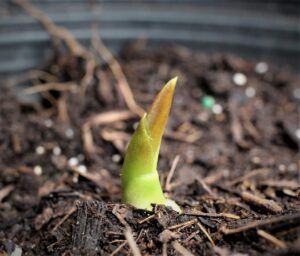
Sprouts remain light green as they emerge from the soil. A slight reddish tint may also be present.
Plant
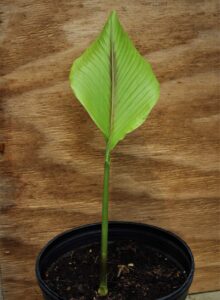
Plants remain light green, with a slight red tint possible toward the bottom of the stem. Leaves may have a light purple stripe down the center, which will not be as dark as in green, blue, or black turmeric leaves. Leaves tend to be wider than those of other purple-striped turmeric varieties.
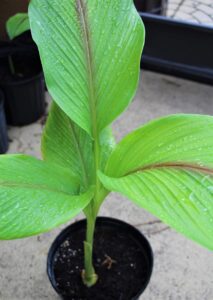
Green Turmeric (Curcuma Longa)
Rhizome
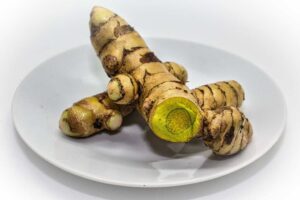
Rhizomes of green turmeric are of medium thickness. Insides are light yellow to light green. Buds light purple to pink when sprouts first emerge.
Sprout

Sprouts remain pink to purple as they emerge from the soil.

Plant
As the first leaf emerges, the stem darkens to a purple hue. Foliage is bright green with a purple stripe down the middle of each leaf. This stripe is generally less dark than that on the curcuma caesias (i.e., blue and black turmerics).
Blue Turmeric (Curcuma Caesia)
Rhizome
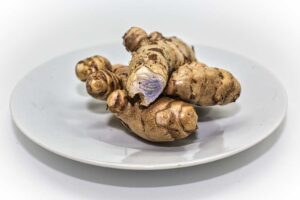
Rhizomes of blue turmeric are medium sized. Insides are light blue or light gray. Buds initially light green when sprouts first emerge.
Sprout
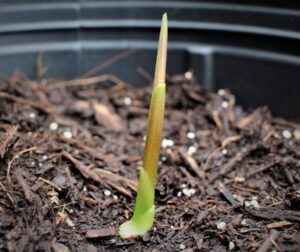
Sprouts remain light green as they emerge from the soil. A reddish hue may also be present as the sprout grows.
Plant
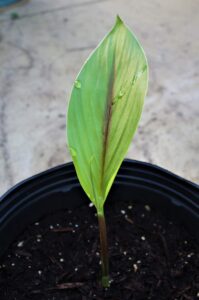
As the first leaf emerges, the stem darkens to a reddish-purple hue. Foliage is bright green with a distinctive deep purple stripe down the middle of each leaf.
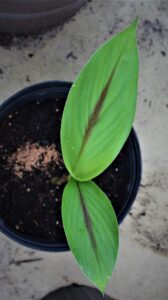
SPECIAL NOTE: This type of turmeric is apparently a cool superfood now. Feel free to use the contact page if you would like to reserve your own blue or black (curcuma caesia) rhizomes for purchase this winter!
Black Turmeric (Curcuma Caesia)
Rhizome
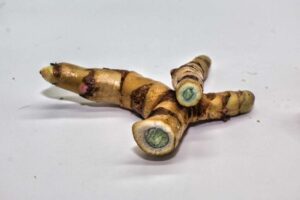
Rhizomes of black turmeric are generally long and thin. Insides are blue to gray. Buds initially deep purple as sprouts begin to emerge.
Sprout

Sprouts remain light green as they emerge from the soil. A reddish or purple hue may also be present as the sprout grows. Some, although not all, black turmeric sprouts have a deeper purple stem than blue turmeric sprouts (see above photo).
Plant
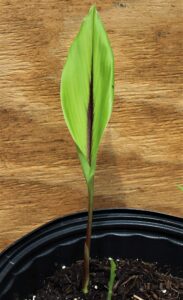
The stem will likely continue to have a purple hue as leaves emerge. Foliage is bright green with a distinctive dark purple to black stripe down the middle of each leaf.

Flower
Flowers may appear in the middle of foliage late-spring to mid-summer . Plants generally will not flower until at least the second year, and may not flower if conditions are not right. The flower petals of black turmeric are generally purple and may have green stripes. Flower buds are pink on the outside with yellow insides.
Identification Tips
Fresh rhizomes will be bright to deep blue. The purple/black stripe down the middle of the foliage is deeper on black turmeric than other varieties.
White Spicy Turmeric (Curcuma Zedoaria)
Rhizome
Rhizomes of white spicy turmeric are medium sized in regard to length. Some are fairly bulbous/plump compared to those of other edible curcumas. Insides are white. Buds white to pink as sprouts begin to emerge.
Sprout
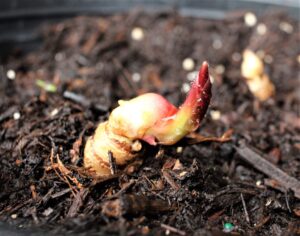
Sprouts turn a deep pink/red hue as they emerge from the soil. This hue remains as the stem grows in height.
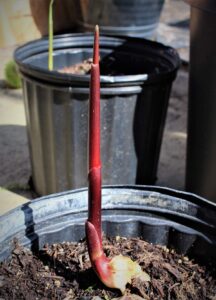
Plant
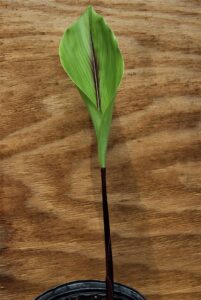
Stems remain a deep red hue as foliage emerges. Large leaves generally have a deep purple (but not black) stripe down the middle.

Identification Tips
White spicy turmeric tends to have the deepest purple stem in a mature plant than any of the other varieties here. Fresh rhizomes are white inside and are generally much larger in diameter than mango ginger/white turmeric.
Mango Ginger/White Turmeric (Curcuma Amada)
Rhizome
Rhizomes of mango ginger tend to be long and thin. Insides are generally white to cream colored. Buds white to light green as sprouts prepare to emerge.
Sprout
Sprouts are generally light to bright green as they emerge from the soil.
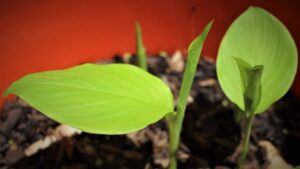
Plant
Plants remain light to bright green as leaves emerge. Foliage is green without additional coloration.
Lookalikes
Pink and Blue Ginger (curcuma aeruginosa)

These rhizomes that resemble blue turmeric. Fresh rhizomes will be a light grey to blue color, but sprouts/growth nodes will be pink (hence the name, pink and blue ginger). Sprouts are light green. The foliage is similar to the above turmeric varieties and has a purple stripe down the middle. Flowers are white with pink tips.
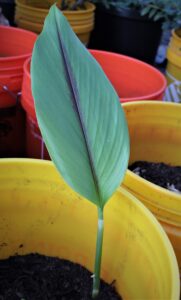
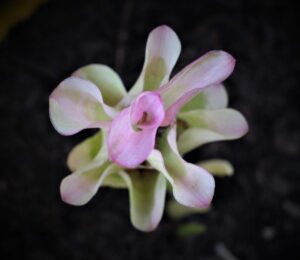
Identification Tips
Unlike the purple-striped turmeric varieties in this post, pink and blue ginger stems are generally light green with no red or purple tint. Additionally, they bloom in the spring, whereas curcuma longa are summer bloomers. If you mistake a pink and blue ginger for a blue/black turmeric, do not fear. They are edible (generally used medicinally).
Key Takeaways
I hope this post has provided some helpful information on distinguishing edible turmeric varieties. This post will be updated over time I am able to take more pictures. Feel free to add any of your own observations in the comments!
Looking for our fresh produce? We’ve moved! You can find us at the Orange City, IA farmer’s market this summer (2023). We plan to have fresh vegetables, fruits, mushrooms, and herbs available this season. We’ll also be selling extra produce at our road market stand in Alton. Feel free to reach out if you’re looking for anything in particular! We can be reached at [email protected].
Interested in basic information on growing turmeric in warm climates? Click here.
Interested in basic information on growing turmeric in cooler climates? Click here.
Already have turmeric you want to turn into powder? Click here.
Looking to make your own turmeric supplements? Click here.





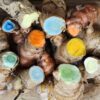
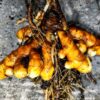
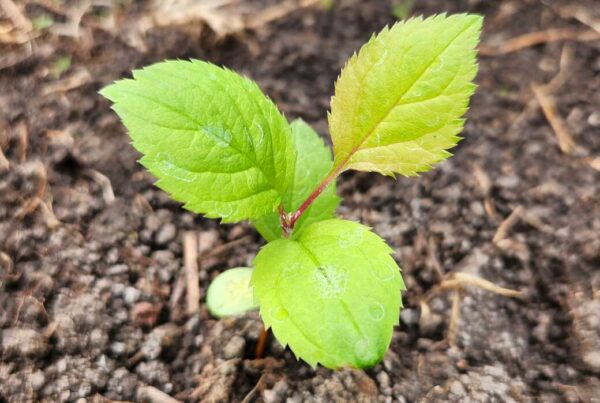
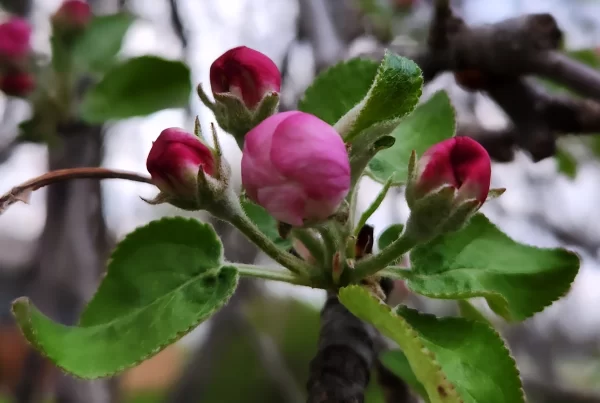
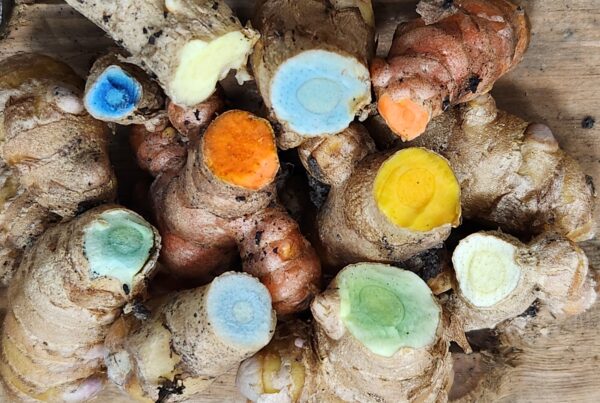

This is really cool! I do not know much about horticulture(correct me if I’m wrong in my terms), but I was looking into blue turmeric one day and stumbled upon this. Thank you for making this information accessible, and easy to understand as well. I really loved how you put photos to illustrate the descriptions, and went the extra mile.
I was curious however, which sources did you refer to? I’m, admittedly, curious and wish to know about the subject so I believed you would know of some credible sources to approach.
Hi Sadaf,
Thanks for your thoughts. From my experience, there is a lack of accessible information on turmeric available in English. The photos taken are all turmeric plants/rhizomes that I have grown, in consultation with local FL (and other southern) gardeners. If you see anything that seems to be incorrect on this post, I’d love to know.
Here is my favorite book on turmeric (admittedly it is an academic read and not the most exciting, unless you think turmeric is really cool):
Turmeric (Curcuma Longa L.) and Ginger (Zingiber Officinale Rosc.) – World’s Invaluable Medicinal Spices: The Agronomy and Economy of Turmeric and Gin
by K.P. Prabhakaran Nair and Kodoth Prabhakaran Nair
Here’s a link where the book can be purchased:
https://www.thriftbooks.com/w/the-agronomy-and-economy-of-turmeric-and-ginger-the-invaluable-medicinal-spice-crops_kp-prabhakaran-nair/14095470/item/57209062/?utm_source=google&utm_medium=cpc&utm_campaign=shopping_everything_else&utm_adgroup=&utm_term=&utm_content=509967659940&gad_source=1&gclid=CjwKCAiA-vOsBhAAEiwAIWR0TXnLFNx8cPbdJNYmxeEQePWzbDr3dNEsBLrhgnJGD01MprzKibeZ7hoC9hwQAvD_BwE#idiq=57209062&edition=58139039
I’m always happy to chat more about turmeric!
Only the most simple informative piece on the varieties of turmeric on the net. One question. I’ve come across the green listed as aromatica. Is this a sub to longa or a different species?
Great question, and one I’m still looking into.
I’ve seen green turmeric listed as curcuma longa, curcuma caesia (often a gray or bluish green), curcuma aromatica, and curcuma zeodoria (all are different species under the genus curcuma) by various retailers. The green turmeric on this page was sold to me years ago as curcuma longa, although I’m not convinced this is true, especially given its purple vein (more similar to caesia than most longas). Now that I’m in the process of building a greenhouse and will be able to house more turmeric again, I plan to source many of these, and then see if my local science department can help with some genetic testing. This may be a few years down the road, but I’ll post more as I can. Feel free to let me know if you find any other intel!
Very informative page, thanks. Are there any tumeric varieties that aren’t edible? We have tumeric growing in our garden that is either self-sown or sown by someone else. We are just trying to identify it – we think it is probably orange tumeric however.
Great question!
In my understanding, there are no turmeric varieties that are toxic when consumed in normal culinary amounts. There have been some research reports of people using curcuma zeodoaria as a flour (this isn’t a common turmeric like curcuma long is), and high levels of consumption of this type seem to have the potential to cause liver damage in rats (but in high doses). There are also reports of excessive turmeric supplements potentially causing liver damage, but this appears to be due to the presence of lead (one of the reasons I make my own supplements).
There are some turmerics/curcumas that taste awful (curcuma caesia) that are typically used for medicinal purposes. Again, they seem safe when used in culinary doses.
I’m happy to take a look at your turmeric if you have pictures of leaves and rhizomes. Hope this helps!